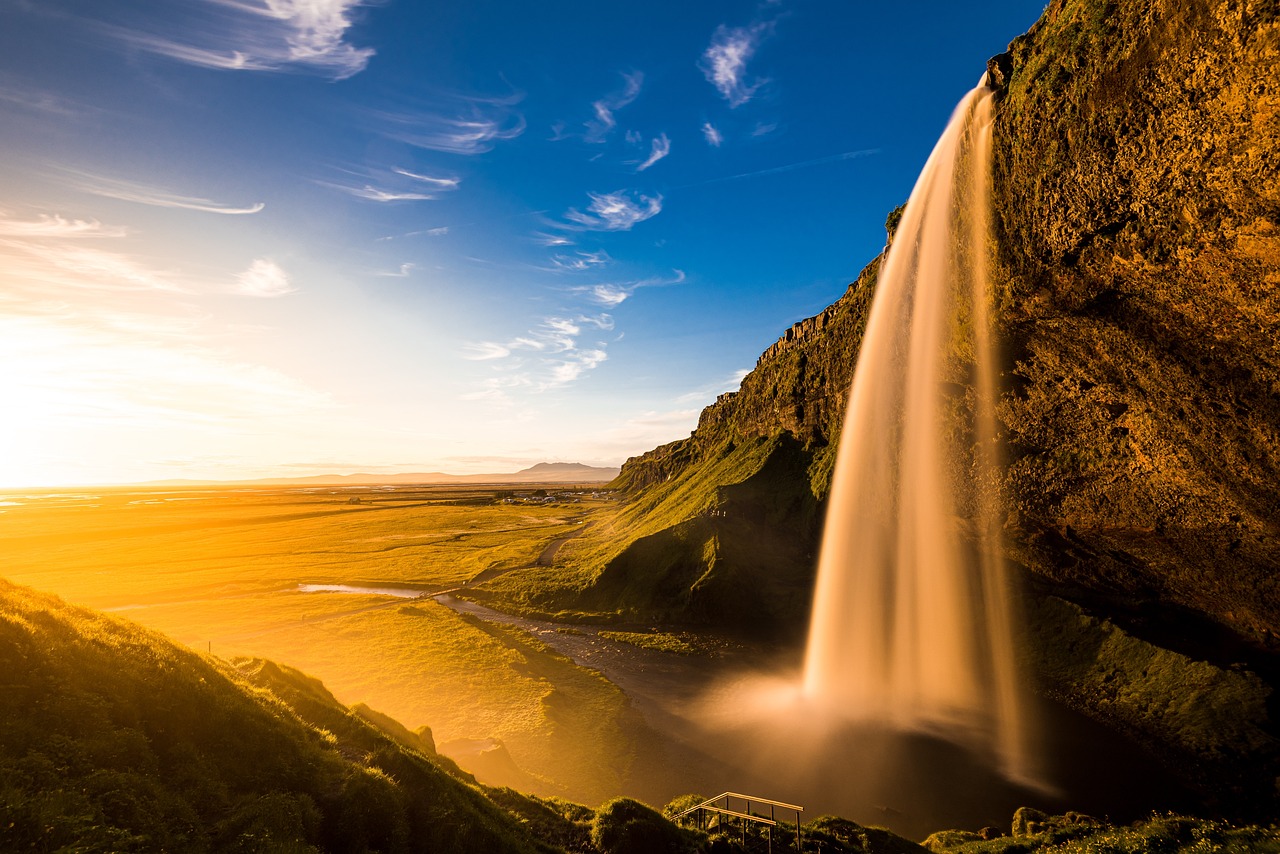Slide Show
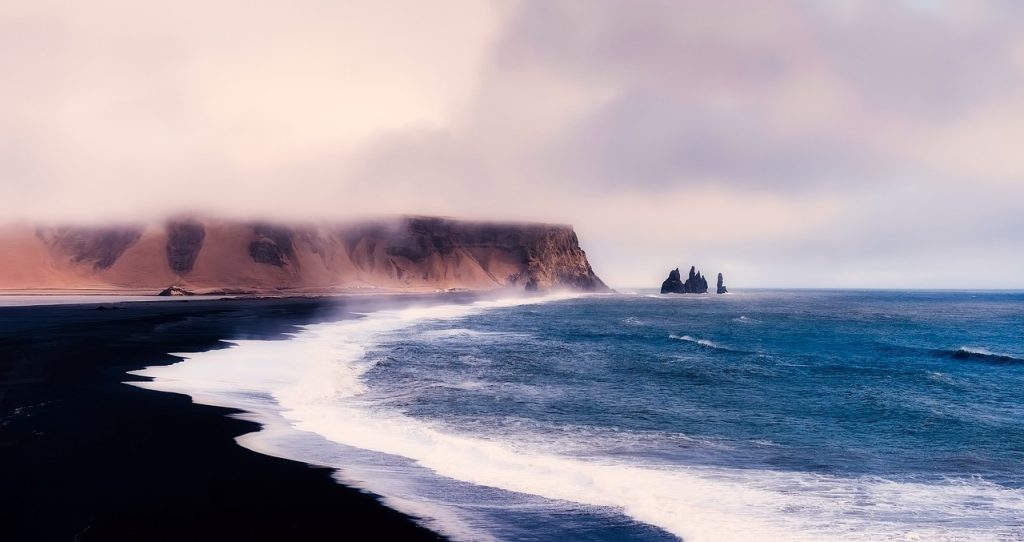
Iceland for Digital Nomads
Iceland is an excellent destination for digital nomads who love nature, adventure, and a vibrant startup scene. The country offers a unique combination of modern infrastructure, stunning landscapes, and a welcoming community of entrepreneurs and creatives.
Here are some things to keep in mind if you are considering Iceland as a destination for digital nomads:
-
Visa requirements: Iceland is a member of the Schengen Area, which means that citizens of most countries can enter the country without a visa for up to 90 days. If you plan to stay longer, you will need to apply for a visa or a residence permit.
-
Cost of living: Iceland is known for being an expensive country, with high prices for food, accommodation, and transportation. However, if you are earning in a strong currency, such as USD or EUR, the cost of living may not be prohibitive.
-
Accommodation: There are many accommodation options in Iceland, including hotels, guesthouses, hostels, and apartments. However, it is advisable to book in advance, especially during the peak tourist season.
-
Transportation: Iceland has a good public transportation system, including buses, taxis, and rental cars. However, if you plan to explore the countryside, it is advisable to rent a car.
-
Weather: Iceland has a subarctic climate, with long winters and short summers. The weather can be unpredictable, with strong winds, rain, and snow. It is important to bring warm clothing, including a waterproof jacket and sturdy shoes.
-
Outdoor activities: Iceland is a paradise for outdoor enthusiasts, with opportunities for hiking, skiing, snowmobiling, and whale watching. However, it is important to take precautions and follow safety guidelines, as the weather and terrain can be challenging.
-
Workspaces: There are many coworking spaces in Reykjavik, including the Icelandic Coworking Unit and the Greenhouse Reykjavik. These spaces offer high-speed internet, comfortable workstations, and opportunities to network with other digital nomads.
Iceland Expat Communities
Iceland has a small but vibrant expat community, with many people from around the world choosing to make the country their home. Here are some resources and tips for finding and connecting with expat communities in Iceland:
-
Facebook groups: There are several Facebook groups for expats in Iceland, such as “Iceland Expats” and “Foreigners in Iceland”. These groups offer a space for expats to share information, ask questions, and connect with one another.
-
Meetup groups: There are several Meetup groups in Iceland that are focused on bringing together expats and international residents. Some examples include “The Reykjavik Expat Meetup Group” and “International People in Iceland”.
-
Expat events: Many expat communities in Iceland organize events and gatherings, such as potluck dinners, cultural festivals, and language exchange meetups. Check online forums and social media groups for information on upcoming events.
-
Expat associations: Some expat communities in Iceland have formed official associations or organizations, such as the Polish Association in Iceland and the Filipino Community in Iceland. These groups may offer additional resources and support for their members.
-
Icelandic language classes: Learning the Icelandic language can be a great way to connect with the local community and make friends. Many language schools in Iceland offer classes specifically for expats and international residents.
-
Workshops and classes: Many expats in Iceland are artists, musicians, and creatives. Attending workshops and classes in your area of interest can be a great way to meet like-minded people and make new friends.
Living As An Expat In Iceland
Living as an expat in Iceland can be a unique and rewarding experience, but it can also come with some challenges. Here are some things to keep in mind if you are considering moving to Iceland as an expat:
-
Cost of living: Iceland is known for being an expensive country, with high prices for food, accommodation, and transportation. Make sure you have a realistic budget in place and factor in the cost of living before you move.
-
Language: Icelandic is the official language of Iceland, and while many Icelanders speak English fluently, it can be helpful to learn some Icelandic phrases to navigate daily life and connect with the local community.
-
Weather: Iceland has a subarctic climate, with long winters and short summers. The weather can be unpredictable, with strong winds, rain, and snow. Be prepared for challenging weather conditions and make sure you have appropriate clothing and gear.
-
Housing: Housing in Iceland can be difficult to find, especially in Reykjavik, where demand is high. It is advisable to start your search early and be prepared to pay a high rent.
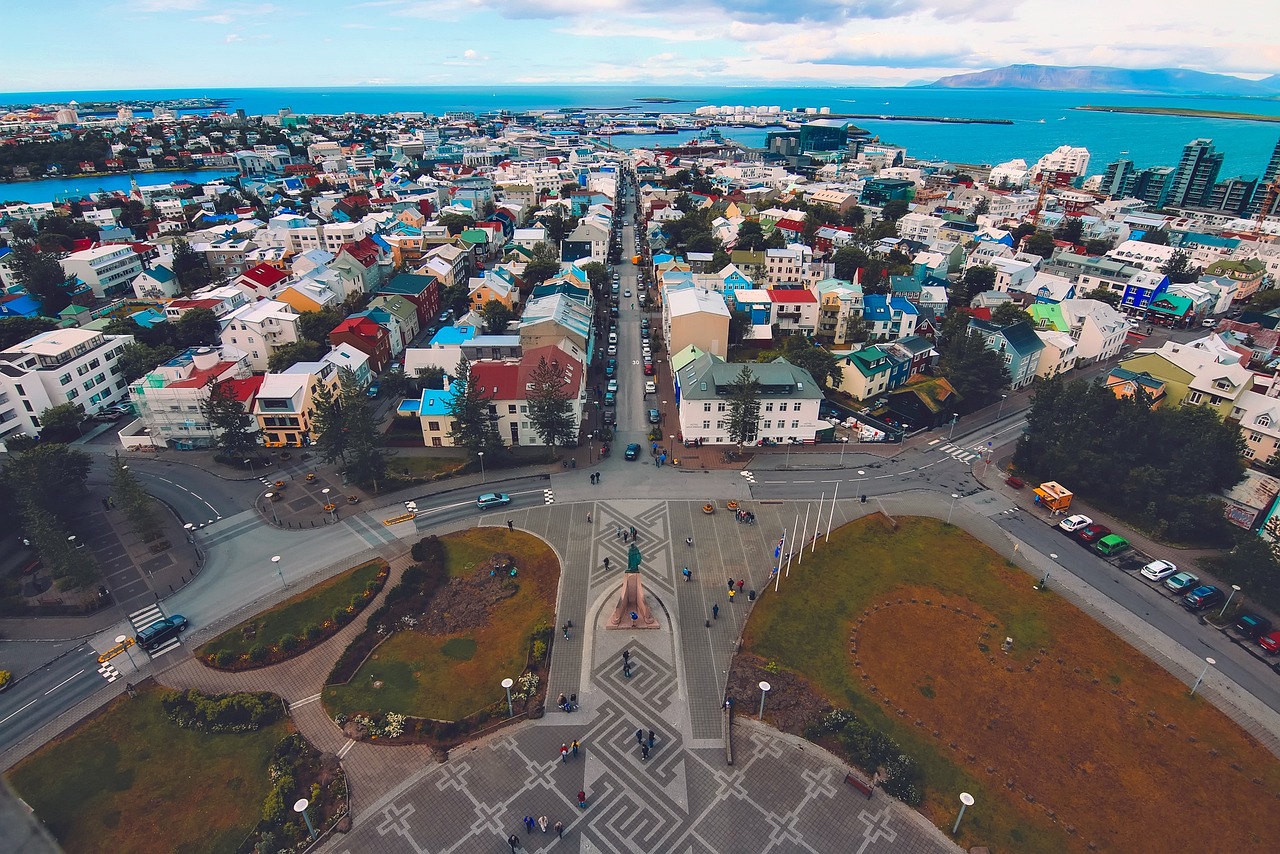
Aerial View of Reykjavik -
Work: Finding work in Iceland as an expat can be challenging, especially if you do not speak Icelandic. However, there are opportunities in certain industries, such as tourism, tech, and creative fields.
-
Culture shock: Moving to a new country can be a culture shock, and it can take time to adjust to a new way of life. Be open-minded and patient, and try to learn as much as you can about Icelandic culture and customs.
-
Healthcare: Iceland has a good healthcare system, and as an expat, you may be entitled to public healthcare if you have a valid residence permit or work permit.
Iceland Facts
- Iceland is a Nordic island country located in the North Atlantic Ocean, with a population of approximately 364,000 people.
- The capital city of Iceland is Reykjavik, which is also the largest city in the country.
- Iceland is known for its natural beauty, including glaciers, hot springs, geysers, and volcanic landscapes. It is often referred to as the “Land of Fire and Ice.”
- Iceland is the most sparsely populated country in Europe, with a population density of only 3 people per square kilometer.
- The official language of Iceland is Icelandic, which is a North Germanic language.
- Iceland is one of the few countries in the world that does not have a standing army.
- The economy of Iceland is largely based on fishing and tourism, with other important industries including aluminum smelting and geothermal energy production.
- Iceland is home to the world’s oldest parliament, the Althingi, which was founded in 930 AD.
- The currency of Iceland is the Icelandic króna (ISK).
- Iceland has a high standard of living and is consistently ranked as one of the happiest countries in the world.
Iceland Official Language
Here are some interesting facts about Iceland:
-
Iceland is the most sparsely populated country in Europe, with a population of just over 360,000 people.
-
Iceland is located on the Mid-Atlantic Ridge, which is where the North American and Eurasian tectonic plates meet. This makes Iceland a hotbed for geothermal activity and volcanic eruptions.
-
Reykjavik, the capital of Iceland, is the northernmost capital city in the world.
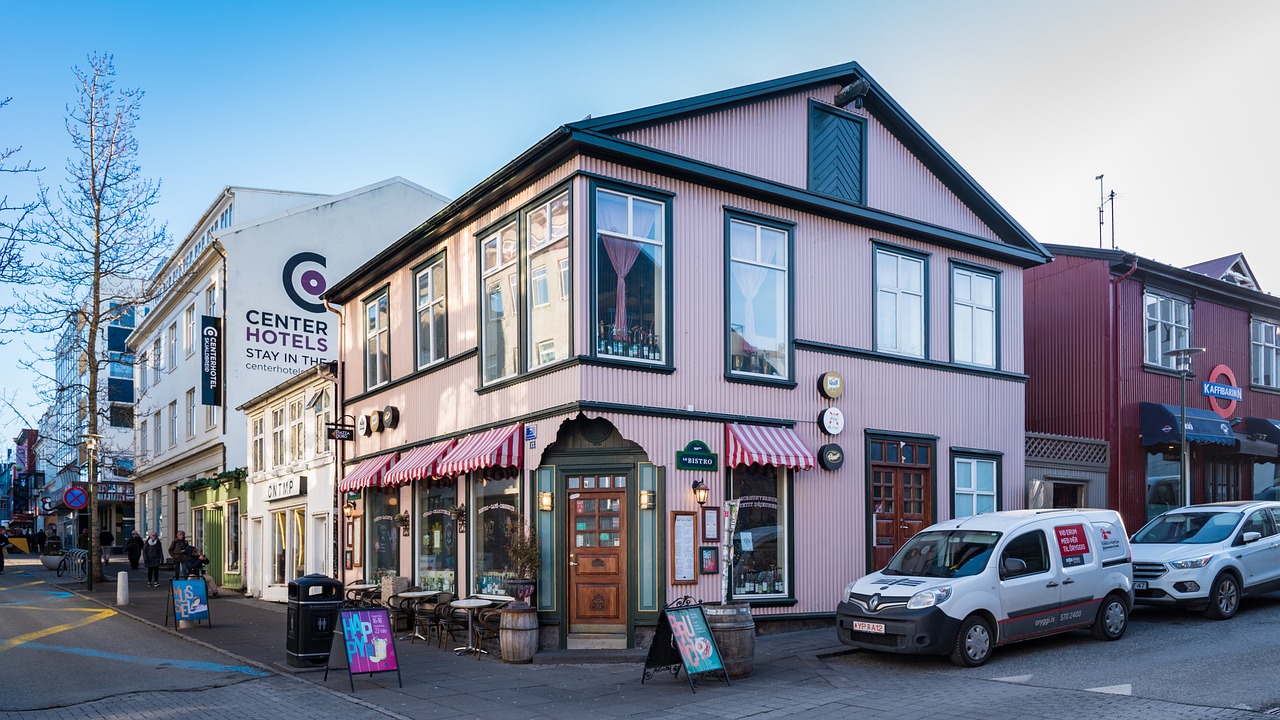
Funky Reykjavik Shop -
Iceland is known as the “Land of Fire and Ice” because it has glaciers and active volcanoes, sometimes in close proximity to each other.
-
Icelanders believe in elves and trolls, and it is not uncommon for new construction projects to be delayed or rerouted to avoid disturbing elf habitats.
-
Iceland is home to the largest glacier in Europe, Vatnajökull, which covers over 8% of the country’s land area.
-
Iceland is one of the few countries in the world with no standing army, and it has been ranked as the most peaceful country in the world.
-
Icelanders are avid readers and publish more books per capita than any other country in the world.
-
The Icelandic language has remained largely unchanged for over 1,000 years, and modern Icelanders can still read the ancient Viking sagas in their original form.
-
The northern lights, or Aurora Borealis, are a common sight in Iceland during the winter months, thanks to the country’s location near the Arctic Circle.
Iceland Visas for Digital Nomads
Iceland offers a digital nomad visa, known as the “long-term residence permit for remote work”. The visa allows foreign nationals to live and work remotely from Iceland for up to six months, with the possibility of extending for an additional six months.
To be eligible for the digital nomad visa, applicants must:
- Be a citizen of a country outside the European Economic Area (EEA) and Switzerland.
- Have health insurance that covers medical expenses in Iceland.
- Have sufficient funds to support themselves during their stay in Iceland.
- Provide proof of employment with a foreign company or proof of self-employment.
- Show that their work can be carried out remotely.
- Not intend to seek employment in Iceland during their stay.
Applications for the digital nomad visa can be submitted online, and the processing time is usually around 30 days. The visa fee is 70,000 Icelandic krona (approximately $550 USD).
The digital nomad visa is a great option for those who want to experience living and working in Iceland while enjoying its unique landscapes and culture. However, it is important to note that the visa does not lead to permanent residency or citizenship in Iceland.
Fun Things to do in Iceland
Iceland is a country with a unique landscape and culture, and there are plenty of fun and interesting things to do during a visit. Here are some suggestions:
-
Visit the Blue Lagoon: The Blue Lagoon is a geothermal spa located in a lava field, and it’s one of Iceland’s most popular attractions. Relax in the warm, mineral-rich water while surrounded by stunning scenery.
-
Take a dip in a hot spring: Iceland is known for its geothermal activity, and there are many natural hot springs throughout the country where you can soak in the warm water and enjoy the scenery.
-
Go on a glacier hike: Iceland is home to some of Europe’s largest glaciers, and guided glacier hikes are a popular activity for visitors.
-
Explore Reykjavik: Iceland’s capital city is full of unique shops, museums, and restaurants. Don’t miss the colorful houses in the old town, or the iconic Hallgrimskirkja church.
-
Go whale watching: Iceland’s waters are home to many different species of whales, and there are several companies that offer whale watching tours.
-
Visit a national park: Iceland has several national parks with breathtaking landscapes, including Vatnajokull National Park, Thingvellir National Park, and Snæfellsjökull National Park.
-
See the Northern Lights: Iceland is one of the best places in the world to see the Northern Lights, or Aurora Borealis. The best time to see them is during the winter months, when the nights are long and dark.
-
Visit a puffin colony: Iceland is home to millions of puffins, and there are several locations where you can see them up close, including the Westman Islands and Dyrhólaey.
-
Drive the Ring Road: The Ring Road is a 1,332-kilometer road that circles the entire country of Iceland, and it’s a great way to see all of the country’s beautiful landscapes and attractions.
-
Try traditional Icelandic food: Icelandic cuisine includes unique dishes like fermented shark, smoked lamb, and skyr (a type of yogurt). Don’t be afraid to try something new!
Popular Iceland Tourist Attractions
Iceland is a popular tourist destination with many unique and breathtaking attractions. Here are some of the most popular tourist attractions in Iceland:
-
The Blue Lagoon: This geothermal spa is one of the most popular tourist attractions in Iceland. Visitors can relax in the warm, mineral-rich water while surrounded by stunning scenery.
-
Gullfoss Waterfall: Gullfoss, or “Golden Falls,” is a massive two-tiered waterfall located in southwest Iceland. It is one of Iceland’s most popular natural attractions.
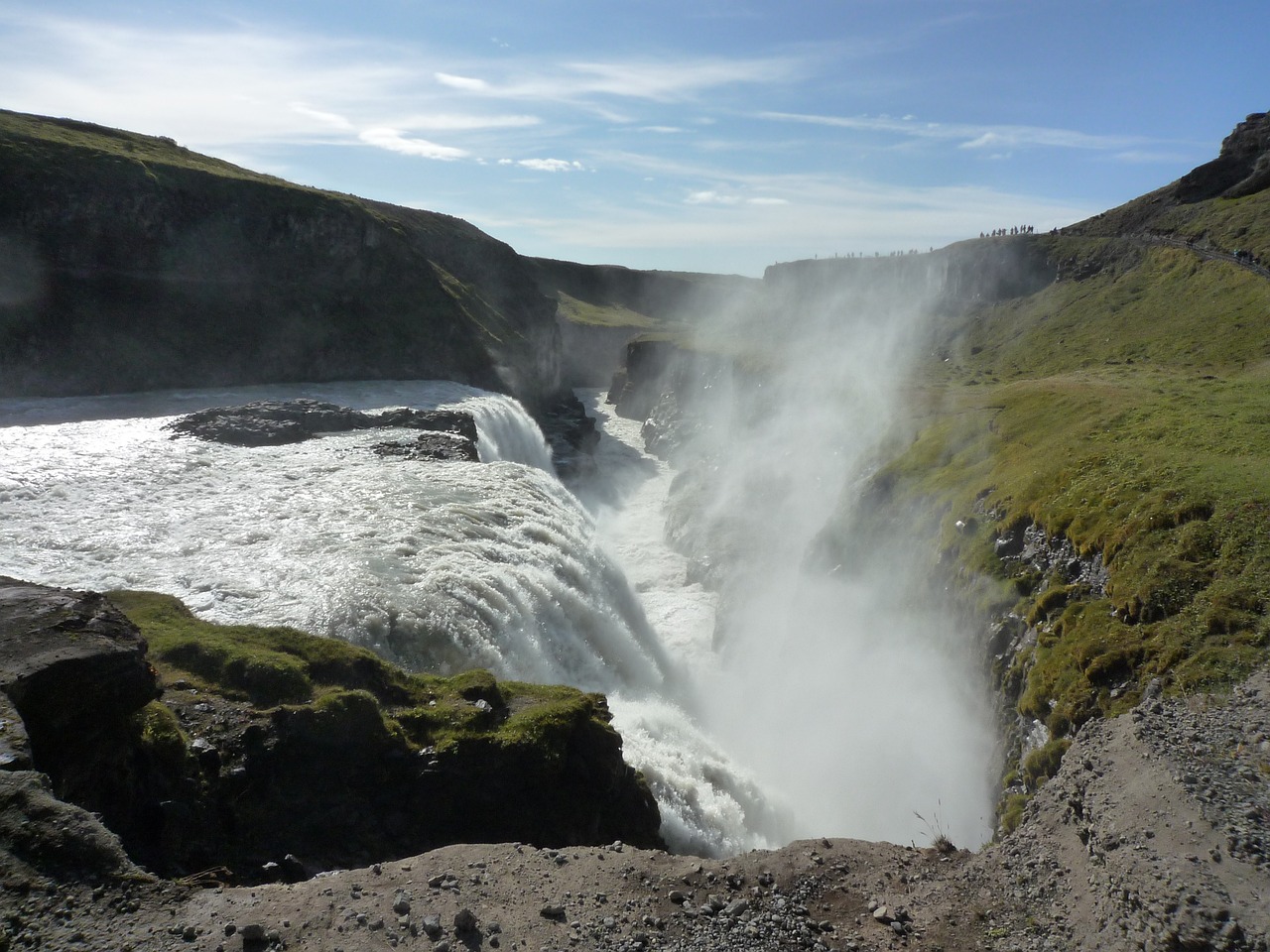
Gullfoss waterfall mist -
Thingvellir National Park: Thingvellir National Park is a UNESCO World Heritage Site that is home to Iceland’s largest natural lake and the site of the world’s oldest parliament, the Althing.
-
Jokulsarlon Glacier Lagoon: This glacial lake in southeastern Iceland is filled with icebergs that have broken off from the nearby glacier. Visitors can take a boat tour or simply admire the stunning scenery.
-
Reykjavik: Iceland’s capital city is full of unique shops, museums, and restaurants. Don’t miss the colorful houses in the old town, or the iconic Hallgrimskirkja church.
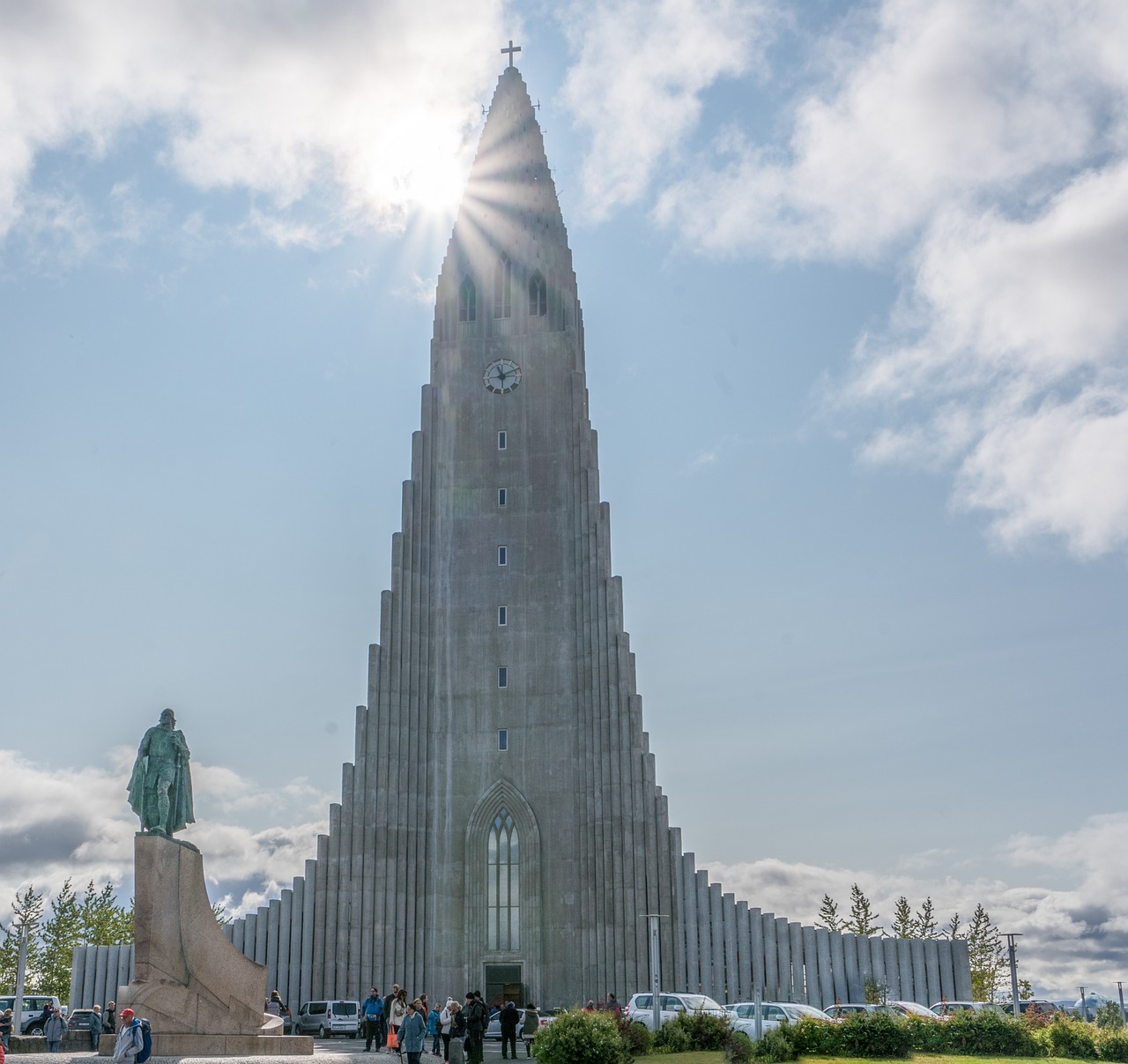
Hallgrimskirkja Church -
The Northern Lights: Iceland is one of the best places in the world to see the Northern Lights, or Aurora Borealis. The best time to see them is during the winter months, when the nights are long and dark.
-
Vatnajokull Glacier: Vatnajokull is the largest glacier in Europe and covers approximately 8% of Iceland’s landmass. Visitors can take guided tours to explore the glacier.
-
Skogafoss Waterfall: This beautiful waterfall is located in southern Iceland and is famous for its impressive size and mist that creates rainbows on sunny days.
-
Myvatn Nature Baths: Similar to the Blue Lagoon, the Myvatn Nature Baths are a geothermal spa located in northern Iceland. Visitors can relax in the warm, mineral-rich water while enjoying stunning views of the surrounding landscape.
-
The Westfjords: The Westfjords is a remote and sparsely populated region of Iceland that is home to dramatic fjords, rugged mountains, and picturesque fishing villages. It’s a great place to get off the beaten path and experience Iceland’s wild beauty.
Popular Iceland Tours
There are many popular tours in Iceland that showcase the country’s unique landscapes, culture, and history. Here are some of the most popular Iceland tours:
-
The Golden Circle: The Golden Circle is a popular day trip from Reykjavik that includes stops at some of Iceland’s most famous attractions, including the Gullfoss waterfall, the Geysir geothermal area, and Thingvellir National Park.
-
Glacier hiking: Iceland is home to many large glaciers, and guided glacier hikes are a popular activity for visitors. Tours typically include transportation to and from the glacier, all necessary equipment, and an experienced guide.
-
The Northern Lights: Iceland is one of the best places in the world to see the Northern Lights, or Aurora Borealis. Many companies offer guided tours that take visitors to the best viewing spots and provide information about the science behind the phenomenon.
-
South Coast tour: The South Coast of Iceland is home to many stunning natural attractions, including the Skogafoss and Seljalandsfoss waterfalls, the black sand beach at Reynisfjara, and the Jokulsarlon glacier lagoon.
-
Whale watching: Iceland’s waters are home to many different species of whales, and there are several companies that offer whale watching tours. The best time for whale watching is during the summer months.
-
Snorkeling and diving: The Silfra fissure in Thingvellir National Park is a popular spot for snorkeling and diving. The water is crystal clear and the unique underwater landscape is unlike anything else in the world.
-
Game of Thrones tour: Many scenes from the popular television series Game of Thrones were filmed in Iceland, and there are several tours that take fans to the filming locations.
-
Food tours: Icelandic cuisine is unique and delicious, and there are several tours that take visitors to local farms, fisheries, and restaurants to sample traditional Icelandic dishes.
-
Super Jeep tours: Super Jeep tours are a great way to explore Iceland’s rugged terrain. These tours take visitors off the beaten path to explore areas that are inaccessible to regular vehicles.
-
ATV tours: ATV tours are another popular way to explore Iceland’s landscapes. Visitors can ride through lava fields, across glaciers, and along the coast while enjoying stunning views of the surrounding scenery.
Popular Iceland Golf Courses
Iceland may not be the first country that comes to mind when you think of golf, but it actually has several beautiful and challenging courses. Here are some of the most popular Iceland golf courses:
-
Keilir Golf Club: Located just outside of Reykjavik, Keilir Golf Club is a challenging 18-hole course with stunning views of the surrounding mountains and coastline.
-
Akureyri Golf Club: This 18-hole course is located in northern Iceland and is known for its well-maintained fairways and beautiful views of the surrounding fjords.
-
Vestmannaeyjar Golf Club: This 9-hole course is located on Heimaey Island, one of the Vestmannaeyjar Islands off the southern coast of Iceland. It’s a challenging course with stunning views of the ocean and nearby volcanoes.
-
Oddur Golf Club: Located in the town of Hvolsvollur in southern Iceland, Oddur Golf Club is an 18-hole course with challenging holes and beautiful views of nearby glaciers.
-
Brautarholt Golf Course: This 18-hole course is located in the town of Hafnarfjordur, just outside of Reykjavik. It’s a challenging course with several water hazards and stunning views of the nearby mountains.
-
Reykjavik Golf Club: This 18-hole course is located just outside of Reykjavik and is one of the oldest and most prestigious golf clubs in Iceland. It’s a challenging course with several water hazards and stunning views of the surrounding mountains and coastline.
-
Akranes Golf Club: This 18-hole course is located on the west coast of Iceland and is known for its well-maintained fairways and challenging holes. It also has stunning views of the nearby mountains and coastline.
-
Husavik Golf Club: This 9-hole course is located in the town of Husavik in northern Iceland and is known for its beautiful views of the nearby mountains and coastline.
-
Golf Course Uthlid: This 9-hole course is located in the heart of Iceland and is known for its challenging holes and stunning views of nearby glaciers.
-
Hveragerdi Golf Club: This 9-hole course is located in the town of Hveragerdi, just outside of Reykjavik. It’s a challenging course with several water hazards and stunning views of the nearby mountains and coastline.
Iceland Population
According to the latest available data from Statistics Iceland, the estimated population of Iceland as of December 2021 was 368,708. This represents a small increase from the previous year’s estimate of 366,425. The population of Iceland is relatively small compared to many other countries, and most of the population is concentrated in and around the capital city of Reykjavik. The population density is relatively low, with an average of only 3.4 people per square kilometer. The population of Iceland has been growing steadily in recent years, largely due to immigration. However, the country still has a relatively homogeneous population, with the majority of residents being ethnic Icelanders.
Iceland Cities
Iceland is a small country with a relatively small population, so there are not many cities in Iceland. However, there are several towns and settlements that are popular with tourists and locals alike. Here are some of the most popular Iceland cities and towns:
-
Reykjavik: The capital city of Iceland and the largest city in the country, Reykjavik is a vibrant and cosmopolitan city that is home to a thriving arts and culture scene, as well as numerous restaurants, bars, and shops.
-
Akureyri: The second largest city in Iceland, Akureyri is located in the north of the country and is known for its stunning natural scenery, including nearby mountains, fjords, and waterfalls.
-
Keflavik: Located near the international airport, Keflavik is a small town that serves as a gateway to Iceland for many visitors. It has several restaurants, shops, and accommodations for travelers.
-
Hafnarfjordur: Located just outside of Reykjavik, Hafnarfjordur is a charming town known for its picturesque harbor and Viking heritage.
-
Selfoss: Located in southern Iceland, Selfoss is a popular destination for tourists due to its proximity to several natural attractions, including the Golden Circle and the southern coast.
-
Akranes: Located on the west coast of Iceland, Akranes is a small town known for its beautiful scenery and historic lighthouse.
-
Borgarnes: Located in western Iceland, Borgarnes is a small town known for its proximity to several natural attractions, including the Snaefellsnes Peninsula and the Langjokull Glacier.
-
Egilsstadir: Located in eastern Iceland, Egilsstadir is a small town that serves as a gateway to the eastern part of the country. It has several restaurants, shops, and accommodations for travelers.
-
Husavik: Located in northern Iceland, Husavik is a small town known for its whale watching tours and stunning natural scenery.
-
Vestmannaeyjar: A group of islands off the southern coast of Iceland, Vestmannaeyjar is a popular destination for tourists due to its volcanic landscapes and abundant bird life.
Reykjavik Iceland for Digital Nomads
Reykjavik is a great city for digital nomads, as it offers a wide range of amenities and services that cater to remote workers. Here are some of the key reasons why Reykjavik is a great choice for digital nomads:
-
High-speed internet: Reykjavik has one of the fastest and most reliable internet networks in the world, making it easy for digital nomads to stay connected and productive.
-
Coworking spaces: There are several coworking spaces located throughout Reykjavik, including the popular Greenhouse coworking space, which offers a range of amenities such as meeting rooms, private offices, and high-speed internet.
-
Coffee shops: Reykjavik is known for its vibrant coffee culture, and there are plenty of cozy cafes and coffee shops throughout the city where digital nomads can work and socialize.
-
Outdoor activities: Reykjavik is located in close proximity to some of Iceland’s most stunning natural landscapes, including glaciers, waterfalls, and hot springs. Digital nomads can take advantage of these outdoor activities during their downtime, helping to balance work and play.
-
Cultural events: Reykjavik is home to a thriving arts and culture scene, with a wide range of events and festivals taking place throughout the year. This provides digital nomads with plenty of opportunities to socialize and network with locals and other expats.
-
Safety: Iceland is consistently ranked as one of the safest countries in the world, making Reykjavik a great choice for digital nomads who are traveling alone or with family. The city is also known for its welcoming and friendly locals, which can help newcomers feel at home quickly.
Reykjavik Coworking Spaces
Reykjavik has several great coworking spaces that cater to digital nomads and remote workers. Here are a few of the most popular options:
-
Greenhouse: Greenhouse is one of Reykjavik’s most popular coworking spaces, offering a range of amenities such as high-speed internet, meeting rooms, private offices, and communal workspaces. It’s conveniently located in the heart of Reykjavik, making it easy to access from anywhere in the city.
-
Klappir: Klappir is a coworking space and innovation hub located in Reykjavik’s trendy Grandi neighborhood. It offers a range of flexible workspaces, including hot desks, private offices, and meeting rooms, as well as access to networking events and workshops.
-
Hús 24: Hús 24 is a coworking space and startup incubator located in downtown Reykjavik. It offers a range of flexible workspaces, as well as access to a community of entrepreneurs and business leaders.
-
Regus: Regus is a global coworking space provider that has several locations in Reykjavik. Its spaces offer amenities such as high-speed internet, meeting rooms, and flexible workspaces.
-
The Hive: The Hive is a coworking space located in Reykjavik’s up-and-coming Hlemmur Square neighborhood. It offers a range of amenities, including high-speed internet, meeting rooms, and private offices, as well as access to a community of local entrepreneurs and business leaders.
AKureyri Iceland for Digital Nomads
Akureyri is a small city located in northern Iceland, surrounded by stunning scenery, mountains, and natural beauty. It’s a great destination for digital nomads who are looking for a peaceful and tranquil environment to work and live.
Here are some factors to consider:
1. Internet Connectivity
Internet connectivity in Akureyri is generally reliable, with several internet service providers offering high-speed internet packages. However, it’s always a good idea to double-check the internet speed and reliability before renting a place.
2. Accommodation
There are several accommodation options available in Akureyri, ranging from apartments to hotels. Rental prices tend to be on the higher side, but this is expected in Iceland. Some popular websites to find accommodation include Airbnb and Booking.com.
3. Coworking Spaces
There are a few coworking spaces in Akureyri that offer a quiet and comfortable environment to work. Some popular options include the Akureyri Business Innovation Center and the Skýrslufélagið.
4. Outdoor Activities
Akureyri is an ideal destination for digital nomads who enjoy the great outdoors. There are several hiking trails, ski resorts, and natural hot springs in the surrounding area. The city is also close to some of Iceland’s most popular tourist attractions, including Lake Mývatn and Dettifoss waterfall.
5. Cost of Living
The cost of living in Akureyri is relatively high compared to other destinations. However, the quality of life is also high, and the natural beauty of the surrounding area more than makes up for the cost.
Keflavik Iceland for Digital Nomads
Keflavik is a town located in southwestern Iceland, near the Keflavik International Airport. It’s a great destination for digital nomads who are looking for a mix of urban amenities and natural beauty.
Here are some factors to consider:
1. Internet Connectivity
Internet connectivity in Keflavik is generally reliable, with several internet service providers offering high-speed internet packages. However, it’s always a good idea to double-check the internet speed and reliability before renting a place.
2. Accommodation
There are several accommodation options available in Keflavik, ranging from apartments to hotels. Rental prices tend to be on the higher side, but this is expected in Iceland. Some popular websites to find accommodation include Airbnb and Booking.com.
3. Coworking Spaces
There are a few coworking spaces in Keflavik that offer a quiet and comfortable environment to work. Some popular options include the Startup Studio and the Tech Park.
4. Outdoor Activities
Keflavik is an ideal destination for digital nomads who enjoy the great outdoors. There are several hiking trails, beaches, and geothermal pools in the surrounding area. The town is also close to some of Iceland’s most popular tourist attractions, including the Blue Lagoon and the Reykjanes Peninsula.
5. Cost of Living
The cost of living in Keflavik is relatively high compared to other destinations. However, the quality of life is also high, and the natural beauty of the surrounding area more than makes up for the cost.
Overall, Keflavik is a great destination for digital nomads looking for a mix of urban amenities and natural beauty. With its reliable internet connectivity, comfortable accommodation options, and abundance of outdoor activities, it’s definitely worth considering as a destination for your next remote work adventure.
Iceland Internet
Iceland has a well-developed and reliable internet infrastructure, making it easy for both residents and visitors to stay connected. The country has high internet penetration rates, with over 98% of the population having access to the internet. Most homes and businesses have access to high-speed broadband, and mobile data coverage is widespread across the country, including in more remote areas.
There are several internet service providers (ISPs) in Iceland, including Vodafone, Nova, and Siminn, that offer various packages with different speeds and data limits. The cost of internet services in Iceland is generally considered to be quite reasonable, with prices ranging from around 3,500-10,000 ISK per month depending on the package and provider.
In addition, Iceland has a number of coworking spaces and other public places, such as cafes and libraries, that offer free WiFi to customers. Many of these spaces also have good facilities for digital nomads, such as quiet workspaces, meeting rooms, and printing and scanning services.
Iceland Cost of Living
Iceland is known for being a relatively expensive country to live in, with prices for goods and services often higher than in other European countries. However, the cost of living in Iceland can vary depending on where you live, your lifestyle, and your individual circumstances. Here are some general things to keep in mind when considering the cost of living in Iceland:
-
Housing: Rental prices in Iceland are generally high, particularly in the capital city of Reykjavik, where the majority of the population lives. A one-bedroom apartment in Reykjavik can cost anywhere from 150,000 to 250,000 ISK per month (approximately $1,200 to $2,000 USD), depending on the location and amenities.
-
Food: Food prices in Iceland are generally higher than in other European countries. A basic meal at a mid-range restaurant can cost around 3,500 to 5,000 ISK (approximately $28 to $40 USD), while groceries for one person can cost around 40,000 ISK (approximately $320 USD) per month.
-
Transportation: Public transportation in Iceland is limited, and most people rely on cars to get around. Gasoline prices are generally high, with a liter of gas costing around 220 ISK (approximately $1.75 USD). Additionally, purchasing a car in Iceland can be expensive due to high import taxes.
-
Healthcare: Healthcare in Iceland is generally considered to be of a high standard, and all residents have access to free or low-cost healthcare services. However, dental care can be expensive, and many Icelanders opt to travel abroad for dental procedures.
Overall, it is important to carefully consider your budget and expenses when planning to live in Iceland, particularly if you are on a fixed income or have limited financial resources.
Iceland Airports
Iceland has several airports, but the main international airport is Keflavik International Airport (KEF), located about 50 kilometers (31 miles) southwest of the capital city, Reykjavik. Keflavik Airport is the largest airport in Iceland and serves as a hub for the country’s national carrier, Icelandair, as well as several other airlines.
There are also several domestic airports in Iceland, including Reykjavik Domestic Airport (RKV), Akureyri Airport (AEY), and Egilsstadir Airport (EGS), among others. These airports serve smaller towns and cities around the country and offer domestic flights to and from Reykjavik.
In recent years, Iceland has seen an increase in tourism, and as a result, several smaller airports have opened to accommodate the influx of visitors. These include Husavik Airport (HZK), located in the northern part of the country, and Vestmannaeyjar Airport (VEY), located on the island of Heimaey off the southern coast of Iceland.
Overall, while Keflavik International Airport is the main point of entry for international travelers to Iceland, there are several other airports throughout the country that provide access to different regions and attractions.
Iceland Accommodation
There are various types of accommodations available in Iceland for tourists, ranging from budget-friendly hostels and guesthouses to luxury hotels and resorts.
Hostels are a popular option for budget-conscious travelers and backpackers. There are numerous hostels located throughout the country, particularly in Reykjavik and other popular tourist destinations. Hostels typically offer dormitory-style rooms with shared facilities, but some also offer private rooms with en-suite bathrooms.
Guesthouses are another affordable option and are particularly common in rural areas of Iceland. These accommodations are similar to bed and breakfasts and typically offer private rooms with shared or private bathrooms.
For those looking for more upscale accommodations, there are numerous hotels and resorts located throughout Iceland, particularly in Reykjavik and other major tourist destinations. These properties range from small boutique hotels to large luxury resorts and offer a range of amenities, such as spas, restaurants, and fitness centers.
In recent years, Iceland has also seen an increase in alternative accommodations, such as vacation rentals and Airbnb properties. These options can offer a more unique and personalized experience for travelers and are particularly popular among those looking to explore Iceland’s natural beauty and rural areas.
Overall, there are plenty of accommodation options available in Iceland to suit all budgets and preferences, whether you’re looking for a budget-friendly hostel or a luxury resort. It’s recommended to book accommodations in advance, especially during peak tourist season, as availability can be limited.
Popular Iceland Hotels
Iceland has many hotels to choose from, ranging from budget-friendly options to luxury accommodations. Here are some of the most popular hotels in Iceland:
-
Ion Adventure Hotel: Located in the scenic Thingvellir National Park, the Ion Adventure Hotel is a luxury property that offers stunning views of Iceland’s natural beauty. The hotel features a restaurant, a spa, and an outdoor hot tub.
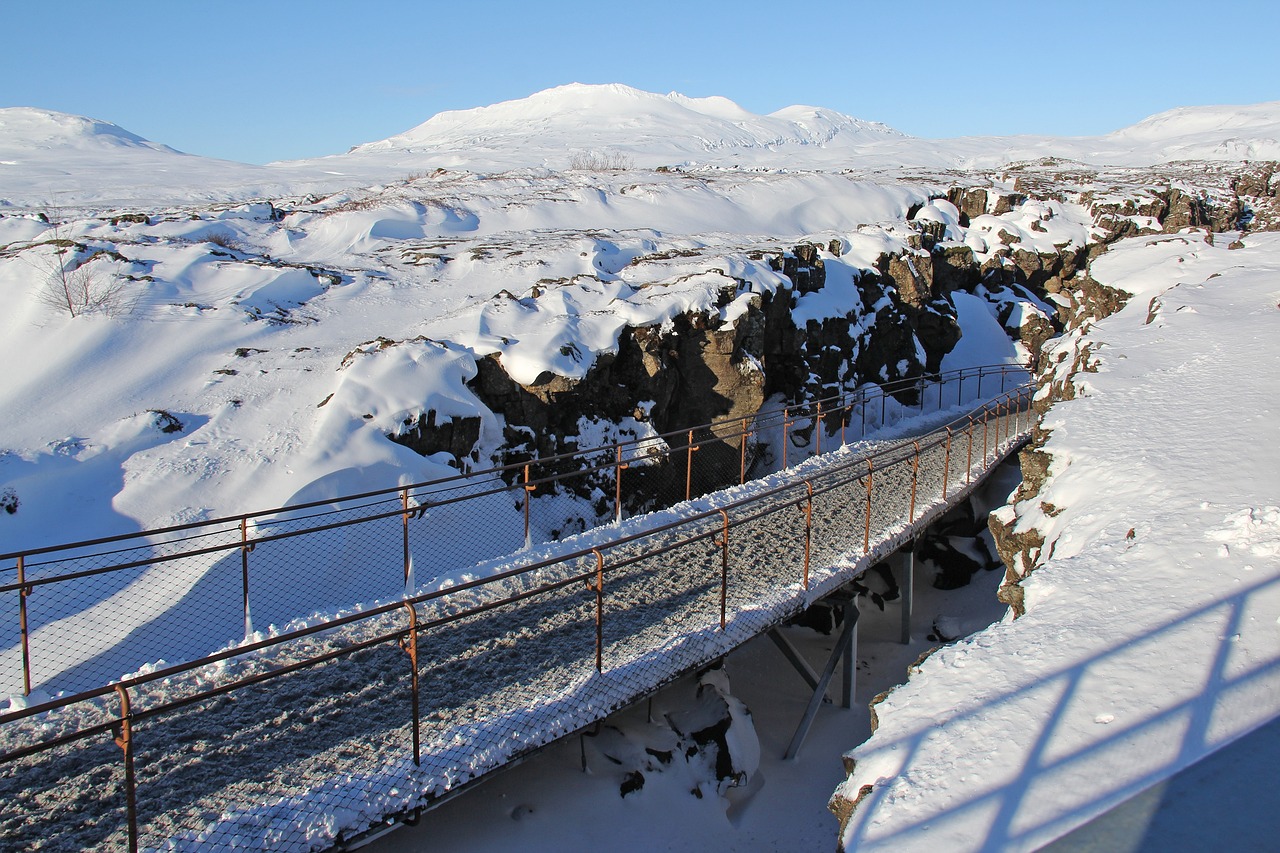
Thingvellir National Park Bridge -
Hotel Rangá: This four-star hotel is located in the countryside near Hella and is known for its comfortable rooms, scenic views, and gourmet restaurant. The hotel also has an observatory with a high-powered telescope for stargazing.
-
Hotel Borg: This luxury hotel is located in downtown Reykjavik and features elegant rooms and suites with Art Deco-inspired decor. The hotel also has a restaurant, a bar, and a fitness center.
-
Fosshotel Glacier Lagoon: This modern hotel is located near Iceland’s famous Glacier Lagoon and features comfortable rooms with floor-to-ceiling windows that offer stunning views of the surrounding landscape. The hotel also has a restaurant and a bar.
-
Hotel Husafell: This luxury hotel is located in the remote countryside of western Iceland and features comfortable rooms, a gourmet restaurant, and an outdoor geothermal pool.
-
Hotel Holt: Located in central Reykjavik, Hotel Holt is a boutique hotel with individually decorated rooms, an art collection, and a restaurant that serves Icelandic cuisine.
These are just a few examples of the many hotels available in Iceland. It’s recommended to research and book accommodations in advance, especially during peak tourist season, as availability can be limited.
Popular Iceland Vacation Rentals
Iceland has many vacation rental options available, ranging from apartments and cottages to houses and villas. Here are some of the most popular vacation rentals in Iceland:
-
Reykjavik Downtown Apartments: These centrally located apartments offer modern amenities and are a great option for those looking to explore Reykjavik’s vibrant culture and nightlife.
-
Northern Light Inn: This cozy hotel and cabin property is located near Iceland’s famous Blue Lagoon and offers comfortable accommodations in a peaceful setting.
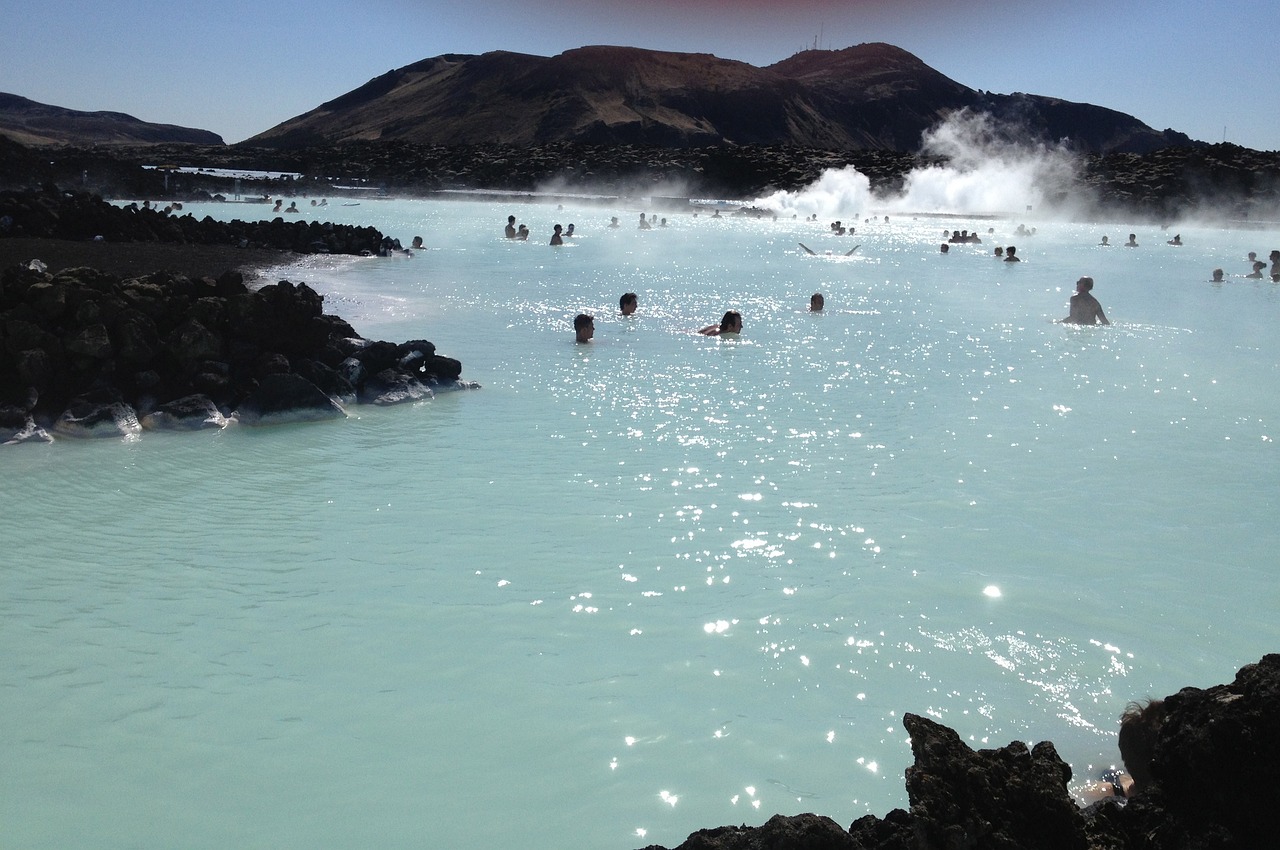
Iceland blue lagoon hot springs -
The Bubble Hotel: These unique accommodations are located in the countryside and offer clear, inflatable domes that allow for uninterrupted views of the night sky and the Northern Lights.
-
The Old Post Office Guesthouse: This charming guesthouse is located in the small town of Stykkisholmur on the Snaefellsnes Peninsula and offers comfortable rooms and easy access to nearby natural attractions.
-
Vatnsholt Guesthouse: This rural guesthouse is located in southern Iceland and offers a range of accommodations, from cozy cottages to spacious apartments. The property also features a restaurant and easy access to nearby hiking trails.
-
Thingvellir Cottages: These cozy cottages are located in Thingvellir National Park and offer easy access to some of Iceland’s most stunning natural attractions, including geysers, waterfalls, and glaciers.
Popular Iceland Apartment Rentals
Iceland has many apartment rental options available, ranging from budget-friendly options to luxury apartments. Here are some of the most popular apartment rentals in Iceland:
-
Reykjavik4You Apartments: These centrally located apartments offer modern amenities and are a great option for those looking to explore Reykjavik’s vibrant culture and nightlife.
-
Luna Apartments: This apartment complex is located in the quiet neighborhood of Laugardalur and offers spacious apartments with fully equipped kitchens.
-
Black Pearl Apartment Hotel: This luxury apartment hotel is located in downtown Reykjavik and offers fully equipped apartments with stylish decor and high-end amenities, such as a private hot tub and sauna.
-
Lighthouse Apartments: This apartment complex is located near Iceland’s famous Reykjanes Peninsula and offers spacious apartments with fully equipped kitchens and scenic views of the surrounding landscape.
-
The Swan House Reykjavik Apartments: This boutique apartment hotel is located in the heart of Reykjavik and offers stylishly furnished apartments with a cozy atmosphere and high-end amenities.
-
Icelandair Hotel Reykjavik Marina Apartments: These luxury apartments are located in the vibrant Reykjavik Harbor area and offer spacious accommodations with modern amenities and stunning views of the harbor.
Iceland Food
Icelandic cuisine is unique and heavily influenced by its natural environment, with many dishes featuring fresh seafood, lamb, and dairy products. Here are some popular Icelandic foods to try:
-
Skyr: A thick, creamy dairy product similar to yogurt that’s high in protein and low in fat.
-
Icelandic Fish: Due to its location in the North Atlantic, Iceland has an abundance of fresh seafood, including cod, haddock, salmon, and Arctic char.
-
Icelandic Lamb: Raised on the country’s grassy hillsides, Icelandic lamb is considered some of the best in the world and is a popular ingredient in many traditional dishes.
-
Plokkfiskur: A traditional Icelandic dish made from boiled fish and mashed potatoes, seasoned with onions and spices.
-
Hákarl: A fermented shark meat that has a strong, pungent flavor and is considered a delicacy in Iceland.
-
Rúgbrauð: A dark, dense rye bread that’s baked in a pot and traditionally eaten with butter or smoked fish.
-
Kleinur: A sweet pastry similar to a doughnut that’s popular in Iceland and often served with coffee.
-
Brennivín: A traditional Icelandic schnapps made from fermented potatoes and caraway seeds.
Popular Iceland Restaurants
Iceland is home to many excellent restaurants that offer a range of dining experiences, from casual cafes to high-end fine dining. Here are some of the most popular restaurants in Iceland:
-
Fish Market: A popular restaurant in downtown Reykjavik that specializes in seafood, offering a range of dishes made with fresh, local ingredients.
-
Grillmarket: A stylish restaurant in Reykjavik that offers a menu featuring Icelandic lamb, beef, and seafood, cooked over an open fire.
-
Matur og Drykkur: A contemporary restaurant located in a former salt fish factory in Reykjavik, that serves traditional Icelandic cuisine with a modern twist.
-
Slippbarinn: A trendy bar and restaurant located in the Icelandair Hotel Reykjavik Marina, that serves a range of Icelandic and international dishes, as well as cocktails and craft beers.
-
Kopar: A seafood restaurant located in Reykjavik’s harbor area, that offers a range of dishes made with fresh, local seafood, as well as Icelandic lamb and beef.
-
Sjavargrillid: A seafood restaurant located in downtown Reykjavik that specializes in grilled seafood dishes, including lobster, scallops, and arctic char.
-
Icelandic Street Food: A casual restaurant located in downtown Reykjavik, that serves traditional Icelandic dishes, such as lamb soup and fish stew.
Iceland Grocery Stores
Iceland has several grocery store chains where visitors can purchase food and other essentials. Here are some of the most popular grocery stores in Iceland:
-
Bónus: A discount grocery store chain with locations throughout Iceland, offering a range of groceries, including fresh produce, meat, dairy, and bakery items.
-
Krónan: Another popular grocery store chain with locations throughout Iceland, offering a range of groceries, including fresh produce, meat, dairy, and bakery items.
-
Hagkaup: A large supermarket chain with several locations throughout Iceland, offering a wide range of groceries, as well as household items and electronics.
-
Nettó: A discount grocery store chain with several locations throughout Iceland, offering a range of groceries, including fresh produce, meat, dairy, and bakery items.
-
Kjarval: A gourmet grocery store located in downtown Reykjavik, offering a range of high-quality, locally sourced groceries, including fresh produce, meat, dairy, and bakery items.
Iceland Climate
Iceland has a subarctic climate that is influenced by the country’s northern location and proximity to the North Atlantic Ocean. The climate is characterized by mild summers and cold winters, with temperature fluctuations throughout the year.
During the summer months (June to August), the average temperature in Iceland ranges from 10°C to 15°C (50°F to 59°F), with occasional heat waves that can bring temperatures up to 20°C (68°F) or higher. During this time, daylight can last up to 24 hours a day, depending on the location in Iceland.
During the winter months (December to February), the average temperature in Iceland ranges from -1°C to 5°C (30°F to 41°F), with occasional cold snaps that can bring temperatures down to -10°C (14°F) or lower. During this time, daylight can last for as little as four hours a day, depending on the location in Iceland.
Due to its location in the North Atlantic, Iceland is also known for its strong winds, frequent storms, and variable weather patterns, which can make the climate feel colder and more unpredictable than the average temperature suggests. Visitors to Iceland should be prepared for changing weather conditions and dress in layers to stay warm and dry.
Iceland Transportation
Iceland has a relatively well-developed transportation system that includes several options for getting around the country. Here are some of the most popular modes of transportation in Iceland:
-
Car: Renting a car is a popular option for visitors who want to explore Iceland’s stunning natural landscapes at their own pace. There are several car rental companies located throughout the country, including international chains and local providers.
-
Bus: Iceland has a network of bus routes that connect many of the country’s major cities and towns, as well as some of its more remote regions. There are several bus companies that offer scheduled services, including Reykjavik Excursions and Strætó.
-
Taxi: Taxis are available in most urban areas of Iceland, including Reykjavik and other major cities. However, fares can be relatively expensive, especially for longer trips.
-
Air: Domestic flights are available in Iceland through Icelandair and Air Iceland Connect, which offer regular services between Reykjavik and several other cities and towns throughout the country.
-
Ferry: Ferries are available to several of Iceland’s offshore islands, including Vestmannaeyjar and the Westfjords. The ferry to Vestmannaeyjar departs from Landeyjahöfn, while the ferry to the Westfjords departs from Stykkishólmur.
It’s worth noting that Iceland’s road network can be challenging to navigate, especially in remote regions where roads may be unpaved or difficult to traverse. Visitors should also be aware of the country’s weather conditions, which can make driving or flying more difficult at certain times of the year.
History of Iceland
Iceland, a Nordic island nation in the North Atlantic Ocean, has a rich history that dates back to the 9th century. The island was first settled by Norse explorers, who arrived in the 870s AD. Ingólfur Arnarson, a Norwegian chieftain, is widely considered the first permanent settler, establishing his farm in Reykjavík in 874 AD. The early settlers brought with them their language, Old Norse, which evolved into Icelandic, a language still spoken today.
The early years of settlement saw the establishment of the Althing, one of the world’s oldest parliamentary institutions, in 930 AD. The Althing played a crucial role in governing the decentralized, clan-based society that characterized medieval Iceland. The country was divided into numerous chiefdoms called goðorð, and disputes were resolved at the annual Althing gathering.
In the late 10th century, Iceland officially converted to Christianity, mainly due to political pressure from Norway. The conversion was relatively peaceful, with the adoption of a compromise that allowed pagan worship in private.
The 13th century marked a period of internal strife, known as the Age of the Sturlungs. This era was characterized by a series of violent conflicts between powerful Icelandic chieftains, ultimately leading to the country’s submission to the Norwegian crown in 1262. This political union, known as the Old Covenant, marked the end of Iceland’s independence for centuries.
In 1380, the Kalmar Union was formed, uniting Denmark, Norway, and Sweden under a single monarch. Iceland, as a part of Norway, was indirectly included in this union. The country experienced a decline in political influence and economic prosperity during this time, with Danish trade monopolies further exacerbating the situation.
The 19th century brought a resurgence of Icelandic nationalism. Inspired by the European Romantic movement, Jón Sigurðsson emerged as a prominent figure advocating for Icelandic independence. In 1874, Iceland was granted a constitution, and in 1904, it gained home rule with a limited degree of autonomy.
On June 17, 1944, following the dissolution of the union with Denmark, Iceland declared full independence, establishing the Republic of Iceland. Since then, the country has developed into a stable democracy with a strong welfare system and has experienced substantial economic growth. Today, Iceland is known for its stunning landscapes, rich cultural heritage, and commitment to sustainable living and renewable energy.
Read also: The History of Iceland: A Comprehensive Exploration

